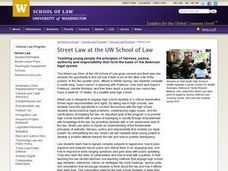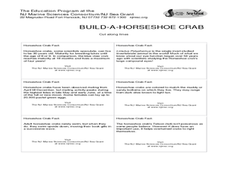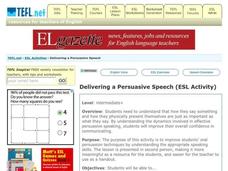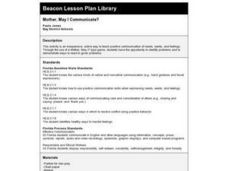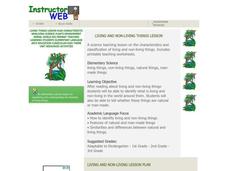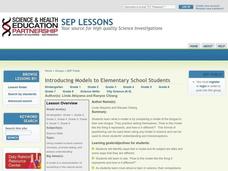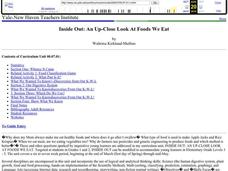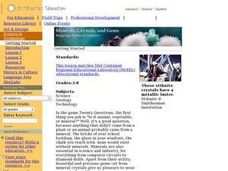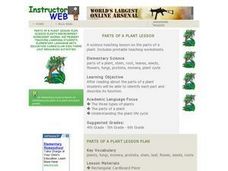Curated OER
Opening Statements (Timed Writing) Model Lesson Plan
Students review purpose and timing of opening statements in mock trials, discuss particulars of what should be included in opening statements, and write individual opening statements based on facts of their case.
Curated OER
Spiders - KidPix
Students answer questions after a story is read aloud, identify and recall the three major body parts of a spider (head, body and 8 legs), construct a spider when given parts of a spider on a handout, and draw and decorate a spider using...
Curated OER
Wet Water, Dry Land
Young scholars observe and examine relationship between landforms and bodies of water, recognizing differences between them. Students then define island, peninsula, isthmus, archipelago, lake, bay, straight, system of lakes, and identify...
Curated OER
Build-A-Horseshoe Crab
Students discover many facts about horseshoe crabs. Students identify the main body parts of horseshoe crab. They explore the habits of the horseshoe crab and their importances to the ecosystem. Adaptations for younger students are...
Curated OER
Help, I can't reach it!
Students learn the major organ systems in the human body and research simple machines on the Internet; They design an informational brochure about a medical profession and present that career topic to the class.
Curated OER
Common and Science Names
First graders investigate how dinosaurs are named. They listen to the book "The Littlest Dinosaurs," discuss Greek and Latin words and word parts, identify the word parts and meanings of Triceratops, and create a drawing of a dinosaur...
Curated OER
Nutrition
Students explore nutrition. In this science lesson plan, students identify and describe the main nutrients in our diets that are needed by the body as a source of energy.
Nemours KidsHealth
Drugs
Young scholars investigate drugs by identifying which ones are illegal and potentially harmful. For this medicine lesson, students complete worksheets in which they role play situations where they have found or ingested drugs and...
Curated OER
Plants and Animals: Partners in Pollination
Students identify the plant parts and bee structures that are involved in pollination. They simulate pollination in a group activity and process the information.
Curated OER
Greek and Roman Myths in Art-A Set of 7 Activities
Young scholars paricipate in seven activities to investigate ancient stories about heroes, monsters, gods, and goddesses.
Curated OER
Delivering a Persuasive Speech
Learners demonstrate the appropriate classroom public speaking and listening skills that would be necessary to influence or change someone's mind or way of thinking about a topic. They define the elements of persuasion and recognize the...
Curated OER
Mexican Food
Students be able to: students identify the foods associated with Mexico and compare and contrast these foods with the foods associated wtih their region of the U.S. They write menus, take quizzes and practice ordering a meal in Spanish.
Curated OER
Mother, May I Communicate?
Students participate in a unique version of the game Mother, May I. They play the game to explore how to positively communicate their needs, wants and feelings, and to demonstrate how to react to problems.
Curated OER
Living And Non-living Things
Students identify what is living and non-living in the world around them. They also tell whether these things are natural or man-made
Curated OER
Insects
Pupils study the characteristics and basic needs of insects. They compare and describe similarities among insects. They examine the body structure, covering, and movement of insects and also, examine insect life cycles in this unit of...
Curated OER
The Water Cycle: A Repeating Pattern in Nature
Students are introduced to the terms related to the water cycle in their native language. In groups, they describe the steps of the cycle using different materials found in their art classroom. They describe how energy helps water...
Curated OER
Introducing Models to Elementary School Students
Students explore the concept of models. In this model lesson, students examine 3-dimensional models of various objects and body parts to better understand the natural world.
Curated OER
One Sniff Can Kill!
Middle schoolers investigate the question: In what ways can a common household products hurt you? This lesson integrates with drug and alcohol units in science classes as well as language arts in the form of the Public Service...
Curated OER
Inside Out: An Up-Close Look At Foods We Eat
Fourth graders identify the origins of meats and vegetables consumed by humans on a daily basis. They classify foods (meats, dairy products, grains...) and create a food pyramid.
Curated OER
Minerals, Crystals, and Gems
Students discover the relationships between minerals, crystals and gems. They bring in rocks that they find at home, in the schoolyard, etc. and examine them and attempt to identify them. They set up a classroom exhibit that includes all...
Curated OER
Parts of a Plant Lesson
Students, after reading about the parts of a plant, identify each part and describe its function.
Curated OER
Views of the American West: True or False?
Students explain that a landscape painting may or may not accurately represent a specific place. They identify techniques that create the illusion of three-dimensional space on a flat surface.
Curated OER
World Fair? A Global Classroom Unit On Economic Rights
Students explore economic rights of people. After listening to statements and songs by people such as John Lennon and Mahatma Ghandi, students examine the truths and values depicted by each person. Students participate in a simulation to...
Curated OER
Game 3-1
In this vocabulary activity, students answer the question, "What is it?" to identify the object in each picture. Each picture features a part of the body. The activity is intended for use with English language learners.


